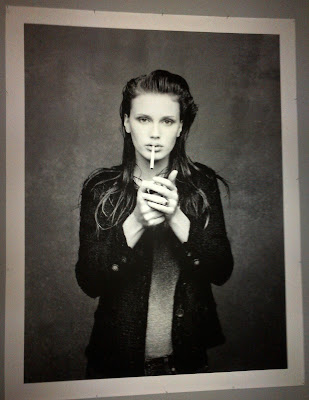Karl Lagerfeld for example has shown his great sense of creativity and business last week by placing an exhibition at Saatchi Gallery London.
The exhibition was called „the little black jacket“ and consisted of „over 100 black and white photographs of Karl Lagerfeld‘s favourite muses wearing the label's iconic jacket - both men and women - fill four expansive rooms, all taken by the Chanel helmer himself“ (Alexander, 2012). The pictures showed international actors, models, celebrities as well as rappers and classical music artists (Chanel, 2012) .
Source: All pictures were taken by myself, Katinka von Flotow.
As this exhibition, in my opinion, was a great marketing strategy, I would like to discuss this in more detail with the help of the marketing mix (product, place, promotion and price) (Schiffman&Kanuk, 2010, p.569), which was discussed in class. -->
1. Product
Althought the photographs show international stars the focus of the exhibition lies on „the little black jacket“. The jacket itself has been designed by Coco Chanel in the 1950s and ever since has been a part of every collection with small changes (Chanel, 2012). To understand how difficult it is to make this jacket and to demonstrate its high quality a video has been created which can be viewed here:
Source: http://www.youtube.com/watch?v=UIYSW9_CCCI
The little black jacket is one of Chanel‘s signature products so therefore it makes sense to create an exhibition around it.
2. Place
As I have mentioned before Saatchi Gallery in London is a luxury brand itself. Furthermore it lies in a sophisticated shopping area near Sloane Square (Kings Road), and the next Chanel shop can be reached within 3 minutes walking distance. Saatchi Gallery is popular for showing modern art and the works of young artists while having very sophisticated visitors, so therefore the image of the place reflects well the core values of the brand and the venue attracts the right target customers of Chanel.
„The little black jacket“ is a touring exhibition that also takes place in metropolises like Berlin, Paris, Sydney, Moskau, Hong Kong, Taipei, New York and Tokyo (Chanel, 2012). It is therefore guaranteed that a wide, international target market will be reached.
3. Promotion
The exhibition has been announced through www.chanel.com as well as an own website (http://thelittleblackjacket.chanel.com/). There has also been an enormous online press coverage - so fashion magazines such as Vogue announced the dates online, too. Moreover, city magazines such as Time Out London also reported about the event. Although I have not been to a Chanel shop recently I am pretty sure that there has been some kind of promotion in the shops as well - maybe in form of a postcard or personal invitations to VIP clients.
As part of the exhibition there was a great promotion going on in the last room. Every visitor could choose a poster for free from a range of three different photographs that were part of the exhibition (Chanel, 2012). This was not only clever in relation to surprising the visitors and letting them take home a free piece and a tangiable memory of the exhibition but also because those posters were so big and given away in transparent plastic bags that people around Sloane Square had to become aware of the exhibition and therefore higher traffic was guaranteed. The fact that people were queing for more than 15 minutes to get a free pictures showed how effecitve this promotion was.
Furthermore a book with all the images as well as the history of the little black jacket has been produced and can be bought in different venues, in Chanel boutiques as well as online.
Source: http://www.lady-blog.de/wp-content/uploads/2012/08/the-little-black-jacket.jpg
Finally it has to be mentioned that Chanel also decided to design some typical London Black cabs to promote the exhibition.
Source: http://farm9.staticflickr.com/8472/8130313803_0f027c82a3_n.jpg
When it comes to dicussing the price one has to take a look at both - the price of the product and the price (admission fee) for seeing the exhibition. The price of the little black jacket is more than 1000 GBP (Chanel, 2012). But as I said before the little black jacket is one of Chanel‘s iconic products and therefore it makes sense to create a big story around it and make people dream by showing amazing pictures of celebrities wearing the jacket. Even if people cannot afford the jacket now this exhibition makes the little black jacket an aspirational product, increases brand awareness and brand visibility and therefore might lead to increasing sales in the future.
Besides the price of the jacket it has to be mentioned that visiting the exhibition was free so people did not have to pay any entrance fees. Therefore there was no barrier to visit the exhibition and as I said before this was a great way of increasing brand awareness.
So all in all after having discussed the exhibition in great detail, the marketing mix shows, that Karl Lagerfeld has done a great marketing coup, which will hopefully result in incresed sales in the future and in an even better perception of the brand than there has been before.
References:
Alexander, E. (2012). Chanel opens little black jacket exhibition. Available from: http://www.vogue.co.uk/news/2012/10/12/chanel-opens-little-black-jacket-exhibition (Accessed: 31.10.2012).
Chanel (2012). The little black jacket. London: Saatchi Gallery.
Mermiri, T. (2010). Arts Sponsorship: The facts, trends and potentail. Journal of Sponsorship, Volume 3, Number 4, p.304-320.
Schiffman, L.G.
and Kanuk, L.L. (2010). Consumer Behaviour, 10th edition.
New Jersey:
Prentice Hall.
The little black jacket (2012). Exhibition Website. Available from: (http://thelittleblackjacket.chanel.com/) (Accessed: 31.10.2012)
von Flotow, Katinka (2012). Images Chanel Exhibition 28.10.2012. London: Saatchi Gallery.
































